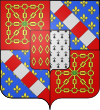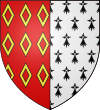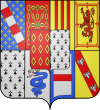The family name of La Rochefoucauld is the combination of the original Lordship held by the family (La Roche) and the first-name of one of the earliest members of the family Foucauld I.
The House of La Rochefoucauld is counted as one of the oldest in France with its first leader recorded in the 10th century; the family maintained a close contact with power through the ages. From being Lords to Comtes and finally in 1622, the family achieved the ultimate honour of being awarded the title of Duc which came with a peerage. That rise was not without merit as the family had proven their loyalty to the crown over and over. For one, Guy VII de La Rochefoucauld fought alongside the king at the Battle of Poitiers where he was eventually killed - right next to the king himself. His descendant, Foucauld III, came to the rescue of Charles III.
Oddly enough, the family had a Protestant branch which had become extinct by the ascension of Louis XIV. When the 5 year-old Louis XIV became king, the family were already dukes and headed by:
1) François V de La Rochefoucauld & Gabrielle du Plessis-Liancourt
Becoming a maréchal de camp, François followed his ancestors in serving the crown martially. It was his choice to join forces with Cardinal Richelieu which eventually secured his elevation to a dukedom.
Gabrielle had served as a fille d'honneur to Marie de Medici in her childhood. She was the daughter of lieutenant general Charles du Plessis.
The couple had twelve children:
- François VI, Duc de La Rochefoucauld
- Louis, Baron de Verteuil
- Marie-Élisabeth, abbess
- Catherine, abbess
- Marie Catherine, Marquise de Puisieux
- Antoinette Jeanne
- Gabrielle Marie, abbess
- Anne Françoise, nun
- Hilaire Charles, chevalier
- Louise, nun
- Aimery, died in childhood
- Henri, abbot
 |
| François V |
2) François VI de La Rochefoucauld & Andrée de Vivonne
Being more bookish than martial, François' extensive Maximes and Memoirs dealt with such serious topics as human nature, including virtue and cynicism. Despite his clear preference for literature, a young man of the nobility as still expected to serve the crown on the battlefield. Luckily for François, he chose the winning side when he joined forces with Anne of Austria and the child-king Louis XIV in the first Fronde; however, he made a crucial mistake when following the Grand Condé during the second outbreak. This left him in a particularly unpleasant situation at his private estates. He would only return to court when Louis XIV assumed absolute power, presumably to avoid the wrath of Cardinal Mazarin.
The marriage was a very young one, even for the times. François was fourteen years old when he married the thirteen-year old Andrée. Their marriage does not appear to have been a close one although they did manage to produce eight children, including an heir, François VII.
 |
| François VI |
3) François VII de La Rochefoucauld & Jeanne du Plessis-Liancourt
François made quite a career for himself at the court of Louis XIV. He was amongst the grand officers of the king's household and had the honour of being a favourite of the king himself. By this point, he had become the focal point of several very prestigious titles besides his own dukedom: Duc de Liancourt, Prince de Marcillac, Duc de Roche-Guyon and governor of Berry. Thanks to Saint-Simon's memoirs - whose friend he certainly was not - the most detailed description of him is remarkably degrading. Saint-Simon considered him rude and ignorant which might be an expression of jealousy as Saint-Simon himself never obtained the privilege of a close relationship with the king.
Jeanne was the daughter of the Comte de Roche-Guyon who served as the king's Premier Gentilhomme de la Chambre; he would likely have met François several times during official duties.
The couple had three children:
- François VIII, Duc de La Rochefoucauld
- Henri Roger, Marquis de Liancourt
- Charlotte, died at 10
 |
| François VII |
4) François VIII de La Rochefoucauld & Magdeleine Charlotte Le Tellier de Louvois
During his military career, François served in the musketeers. He was amongst the officers sent to the Palatinate during Louis XIV's assault on this state in the name of his sister-in-law, Elizabeth Charlotte. While fighting at Nerwinden, François was gravely injured and it was feared that he would die. When he recovered, he was rewarded with the promotion to maréchal de camp. Through his grandmother, he inherited the dukedom of Liancourt.
Magdeleine was the daughter of Louis XIV's infamous minister Louvois. She would present her husband with no fewer than ten children of which half died young:
- François, died at 19
- Charles Maurice, died at 10
- Michel Camille, died at 28
- Roger, abbot
- Guy, died at 10
- Magdeleine, nun
- Alexandre, Duc de La Rochefoucauld
- Aimery, died at 8
- Guy, Duc de Roche-Guyon
- Émilie, Duchesse de Crussol
 |
| François VIII |
5) François IX de La Rochefoucauld
François died of smallpox at the age of 18 without leaving heirs.
6) Alexandre de La Rochefoucauld & Élisabeth-Marie-Louise-Nicole de Caylard de Toiras d'Amboise
Alexandre was an unlikely duke. He was born as the sixth son and thus had very little chance of inheriting anything; yet, a tragic series of untimely deaths catapulted him to one of the grandest positions at court. When entering into his military service he made the surprising choice of leaving the landed forces to enter France's new naval force. After having served several years at sea, he transferred to a cavalry unit. At court, he was a close friend of Louis XV which eventually helped him with his succession issue.
The many-named Élisabeth-Marie-Louise-Nicole was an odd choice of bride for a Rochefoucauld. She was not the daughter of a fellow duke, nor a prince. Her father was the Marquis de Toiras while her mother was Marquise de Vestric in her own right.
The couple had five children:
- Marie-Louise-Élisabeth, Duchesse de La Rochefoucauld
- François, died at 1
- Marie, Duchesse d'Estissac
- François, died at 1
- Adélaide, died at 15
Through papal dispensation, the couple's eldest daughter was permitted to inherit with the extinction of the male line.
7) Marie-Louise-Élisabeth de La Rochefoucauld & Jean-Baptiste Louis Frédéric de La Rochefoucauld de Roye
The accession of Marie-Louise-Élisabeth was astonishing. Salic Law typically banned females from inheriting titles but her father, Alexandre, managed to obtain the permission of both king and pope for this unusual inheritance. The only stipulation was that she was to marry another Rochefoucauld. Marie herself appear to have been intelligent; she was admired by the visiting American John Addams for her skillful observation skill.
Jean-Baptiste was Marie-Louise-Élisabeth's cousin which ensured that the title would remain in the family. He joined the French navy and was bestowed the title of Duc d'Anville; he is primarily known for the disastrous expedition named after him: the d'Anville Expedition. The fleet set out headed for North America but was hit by immensely poor luck; before long the fleet had been scattered from the Caribbean to Canada's coast with some ships even returning to France. Jean-Baptiste himself reached Canada but was then struck down by tuberculosis and buried there.
The couple had four children:
- Louis Alexandre, Duc de La Rochefoucauld
- Élisabeth Louise, Princesse de Léon
- Unnamed daughter
8) Louis-Alexandre de La Rochefoucauld & 1) Louise-Pauline de Gand de Mérode de Montmorency, 2) Alexandrine Charlotte de Rohan-Chabot
Inheriting his father's dukedom of Anville in 1746, he would was a key proponent of French assistance in the American Revolution; amongst others, he became a close friend of Benjamin Franklin. On the eve of the revolution, he was amongst the nobles who were elected to the Estates General in 1789. Naturally worried at the rapidly deteriorating situation, he attempted to flee Paris to help his mother and wife. On his way, he was caught and massacred by a band of volunteer troops who had made aristocrat-hunting a favourite pastime.
Louis-Alexandre and Louise-Pauline had no children.
Disturbingly, Alexandrine was Louis-Alexandre's own niece and twenty years his junior. Yet again, the marriage proved to be sterile. Yet, Alexandrine managed to survive the revolution and went on to remarry (to another relative...)
 |
| Louis-Alexandre |
 |
| Alexandrine |
9) François XII de La Rochefoucauld & Félicité-Sophie de Lannion
The cousin of Louis-Alexandre, François was the son of the Duc d'Estissac and held the title of Duc de Liancourt himself. Like his predecessor, he was amongst the nobles at the Estates General where he continued to support the monarchy but campaigned for social reform. He had travelled quite a bit to England and gotten considerable inspiration particularly regarding farming, vaccination and weaving. It was he who was hunting with Louis XVI when the Bastille was stormed; when the king declared that another revolt had broken out, François infamously replied: "No, Sire, it is a revolution".
Félicité-Sophie was the daughter of the Marquis de Lannion who held the rank of lieutenant general in the king's army.
The couple had four children:
- François XIII, Duc de La Rochefoucauld
- Alexandre-François, Comte de La Rochefoucauld
- Aglaé Émilie Joséphine
- Frédéric Gaëtan, Marquis de Liancourt
 |
| François XII |
 |
| Félicité |
Interesting fact and anecdotes:
- Michel Camille, third son of François VIII is quite an oddity - by all appearance, he should have assumed some sort of title or position but at his death at 28, he had neither. In contrast, the heir apparent became his younger brother which inevitably raise the question: what prevented Michel Camille from inheriting? Perhaps a disability?
- François XII's sister-in-law, Anne Alexandrine Rosalie, was amongst the victims of the Terror; she was executed in 1794
- François VI had an affair with the sister of the Grand Condé which prompted an unusual story. She had considerable influence over François and openly urged him to demand a tabouret for Andrée at court; however, Mazarin did not chose the Duchesse de La Rochefoucauld to be amongst those who were given that usual right. It is widely believed that it was this snub which made him turn against Anne of Austria's party















































